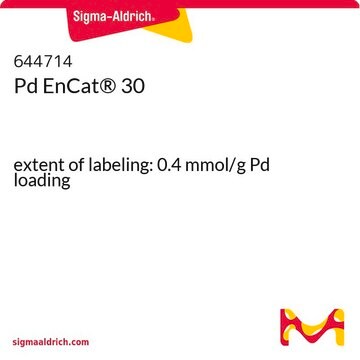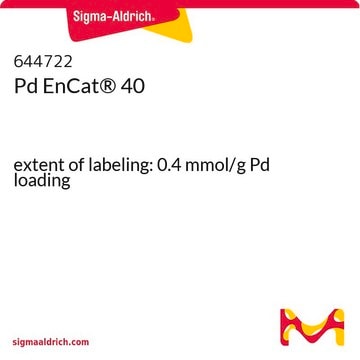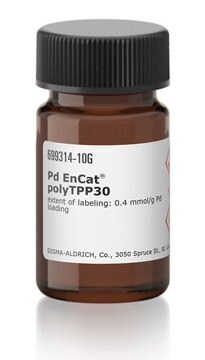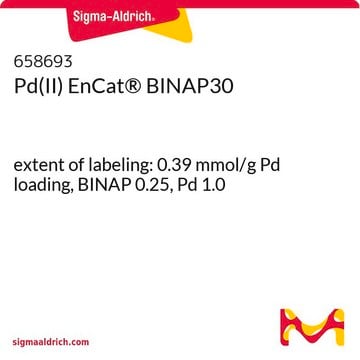644706
Pd EnCat® TPP30
extent of labeling: 0.4 mmol/g Pd loading, TPP 0.8, Pd 1.0
Synonym(e):
Palladiumacetat und Triphenylphosphin in Polyharnstoffmatrix microeingekapselt, 0.4 mmol Pd/g, 1.0/0.8 Pd/TPP
About This Item
Empfohlene Produkte
Enthält
0.26-0.35 mmol/g phosphorous
0.37-0.44 mmol/g palladium
Zusammensetzung
Pd, 1.0
TPP, 0.8
Eignung der Reaktion
core: palladium
reaction type: Buchwald-Hartwig Cross Coupling Reaction
reaction type: Heck Reaction
reaction type: Hiyama Coupling
reaction type: Negishi Coupling
reaction type: Sonogashira Coupling
reaction type: Stille Coupling
reaction type: Suzuki-Miyaura Coupling
reagent type: catalyst
Kennzeichnungsgrad
0.4 mmol/g Pd loading
Allgemeine Beschreibung
Anwendung
- Aryl iodides and bromides with terminal alkynes to form the corresponding coupling products under copper-free conditions.
- Bromobenzotriazoles and arylacetylenes in the presence of 1,5-diazabicyclo[5.4.0]undecene-5-ene (DBU) and copper iodide to form 2H-benzo[d][1,2,3]triazole derivatives.
Leistungsmerkmale und Vorteile
- low residual metal levels in crude product
- easy recovery of catalyst
- compatibility of immobilized metal with various ligands to effect C-C bond forming reactions
- safer and easier to handle than Pd/C for hydrogenation
- efficiency and economy gains through recovery and recycling
Sonstige Hinweise
Rechtliche Hinweise
Signalwort
Warning
H-Sätze
Gefahreneinstufungen
Aquatic Chronic 3 - Carc. 2 - Flam. Sol. 2 - Repr. 2 - STOT RE 2 Oral
Zielorgane
Liver,Kidney
Lagerklassenschlüssel
4.1B - Flammable solid hazardous materials
WGK
WGK 3
Flammpunkt (°F)
-9.4 - -7.6 °F
Flammpunkt (°C)
-23 - -22 °C
Persönliche Schutzausrüstung
dust mask type N95 (US), Eyeshields, Gloves
Analysenzertifikate (COA)
Suchen Sie nach Analysenzertifikate (COA), indem Sie die Lot-/Chargennummer des Produkts eingeben. Lot- und Chargennummern sind auf dem Produktetikett hinter den Wörtern ‘Lot’ oder ‘Batch’ (Lot oder Charge) zu finden.
Besitzen Sie dieses Produkt bereits?
In der Dokumentenbibliothek finden Sie die Dokumentation zu den Produkten, die Sie kürzlich erworben haben.
Verwandter Inhalt
Homogeneous palladium catalysts are widely utilized due to their versatility, reactivity and functional group tolerance.
Unser Team von Wissenschaftlern verfügt über Erfahrung in allen Forschungsbereichen einschließlich Life Science, Materialwissenschaften, chemischer Synthese, Chromatographie, Analytik und vielen mehr..
Setzen Sie sich mit dem technischen Dienst in Verbindung.





![[Pd(OAc)2]3 reagent grade, 98%](/deepweb/assets/sigmaaldrich/product/structures/508/249/99a0ef2c-b77c-4d73-8ed9-0cca05b6b41f/640/99a0ef2c-b77c-4d73-8ed9-0cca05b6b41f.png)


![RuCl(p-cymene)[(R,R)-Ts-DPEN]](/deepweb/assets/sigmaaldrich/product/structures/161/670/212e6eb8-dce1-4397-a5ef-3e2e3a296e8c/640/212e6eb8-dce1-4397-a5ef-3e2e3a296e8c.png)

